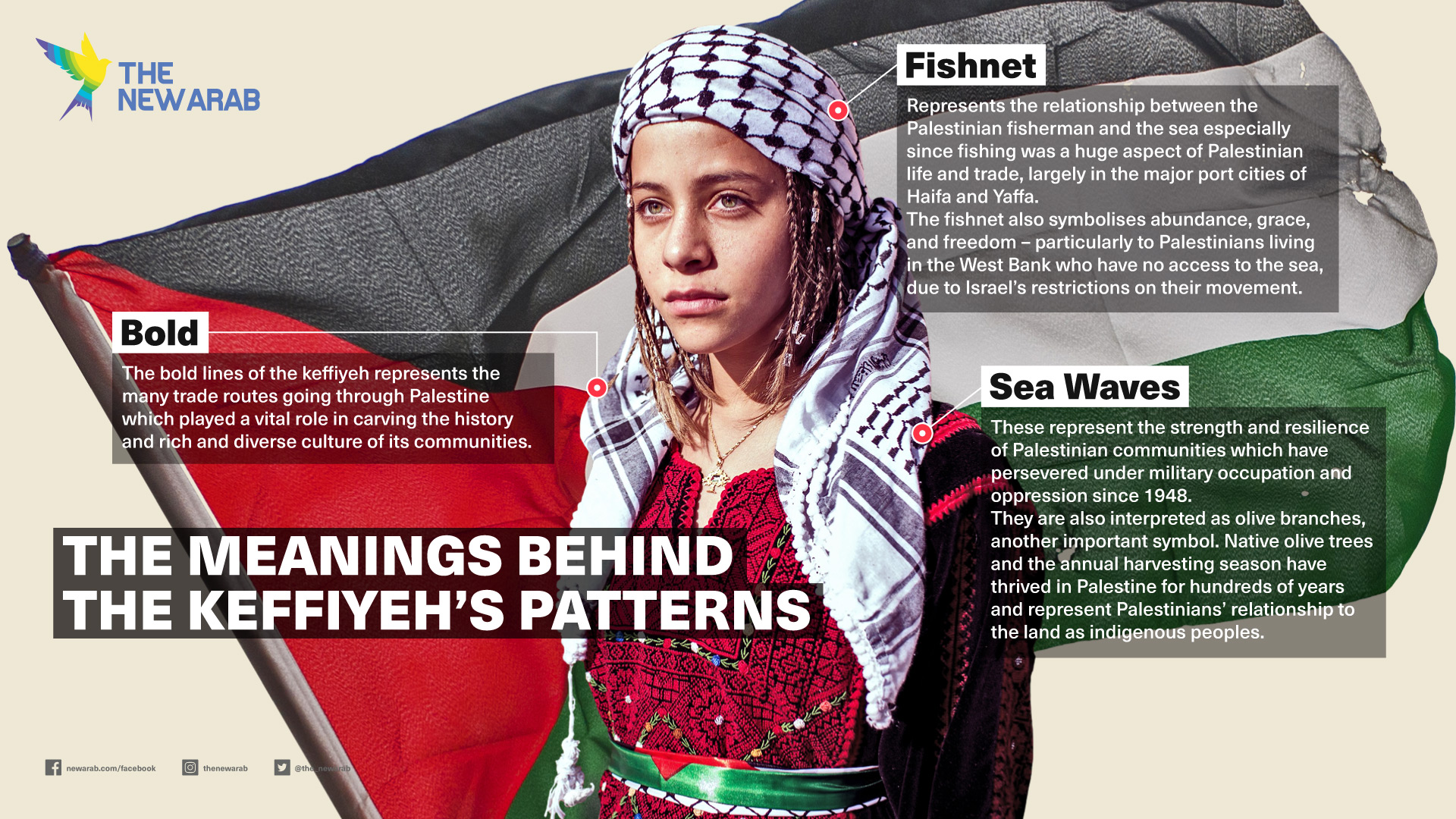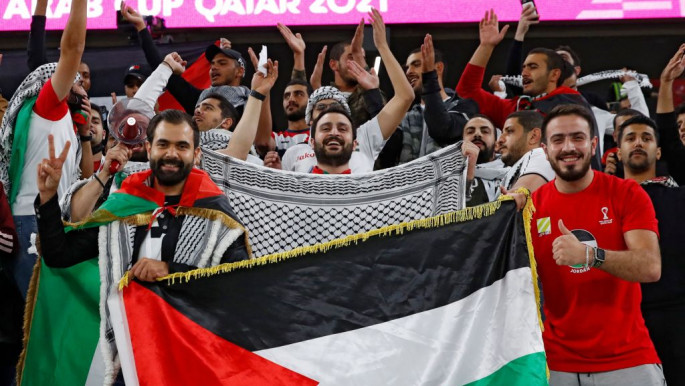
Raise the Keffiyeh, the unofficial flag of Palestine

On Wednesday, Palestinians marked World Keffiyeh Day to celebrate one of the most prolific symbols of Palestine’s culture.
Wearing the black and white scarf is used as a marker of identity and a token of solidarity with the cause.
On the surface, it is an accessory that is loved by millions, but the connotations behind it are a lot deeper than what initially meets the eye.
"The Palestinian keffiyeh serves the same purpose in functionality and status, with it bringing an air of authority and presence, but it’s also a reminder that the Palestinian campaign for freedom is alive and here to stay"
As an item, the keffiyeh is used across the Arab world and has different uses. Its primary functional use is for protection from sun and sand and has different names and patterns and colours depending on the part of the Middle East and North Africa.
In Jordan, the keffiyeh also called a shemagh or a hatta, is red and white, which represents the colours of the Arabian deserts.
Saudi Arabia has the same pattern but it’s called a ghitra in their dialect. The Kuwaiti ghitra is white and supported with a black headband called an agal, whereas, in Oman, the scarf is called a masar and is worn as a turban. All are used as status symbols.
The Palestinian keffiyeh serves the same purpose in functionality and status, with it bringing an air of authority and presence, but it’s also a reminder that the Palestinian campaign for freedom is alive and here to stay.
It was originally worn by farmers, but political connotations of the keffiyeh began during the 1936–1939 Arab revolt in Palestine when resistance fighters wore it over their faces to protect their identity from British soldiers.
Subsequently, the scarf became a symbol for “trouble makers” for the British, who would arrest Palestinians wearing them under suspicion. This solidified the keffiyeh a symbol of Palestinian resistance and was even banned by Israel between the years of 1967 and 1993, along with Palestine’s flag.
As resilient as they are, Palestinians ended up walking around with slices of watermelons because it naturally features the colours of the Palestinian flag – along with the colours of the keffiyeh.
The design of the scarf considers the minute detail of Palestine’s culture. The printing on the keffiyeh is said to have three symbols for Palestine. The bold lines symbolise Palestine’s trade because it was a hub for importing and exporting goods for the whole region.
The olive leaves represent a symbol of Palestinian culture and resistance and reliance on olives for the economy.
The fishnet pattern on the keffiyeh also represents Palestine’s famous fishing industry which is still a lifeline for the besieged Gaza Strip’s economy but is also a metaphor for the sea being an escape from Israeli occupation.
"Wearing a keffiyeh with pride, regardless of whether a person is Palestinian or not is another power move because it facilitates the local Palestinian economy and keeps Palestine on the radar"
For decades, Palestinians and Arabs have used the Palestinian keffiyeh as a marker of solidarity with the cause. People wore it around their heads and necks in various styles.
How a person wore it never really mattered, as long as they were wearing it and representing Palestine with pride. It was and is still used by Palestinians to protect themselves from Israeli teargas, especially in the occupied West Bank where they are subjected to such attacks the most.
Yasser Arafat, then-leader of the Palestine Liberation Organization (PLO), famously lifted his keffiyeh off the top of his head to represent Al-Aqsa Mosque’s golden Dome of the Rock.
He often draped his keffiyeh off his right shoulder so it somewhat resembles a map of Palestine and famously addressed the United Nations General Assembly in 1974 in this fashion.
Ironically, critics of Arafat blame him for the demise of the sentiment of the keffiyeh because of the way it became mass-produced after he signed the Oslo Accords in 1993.
The keffiyeh is also commonly referenced in Palestinian music, with ‘ale al keffiyeh’, meaning ‘raise the keffiyeh’ by famous singer Mohammed Assaf being a song commonly played at weddings and is spun around during dabkeh – Palestine’s national dance.
Three cheers for sweet appropriation
The original Palestinian keffiyeh is made of a sturdy cotton material that is meant to withstand environmental or wear-and-tear distress. There is only one factory in the whole of Palestine that produces the original keffiyeh which is the occupied West Bank city of Hebron.
Nowadays, the majority of keffiyehs in the market are mass-produced with flimsy material and no attention to its cultural significance or meaning.
Fashion designers and fast-fashion retailers have also taken to the keffiyeh as a quirky pattern to be mindlessly mass-produced.
Activists say this saturates the meaning of the scarf, which is often regarded as Palestine’s second or unofficial flag and takes on a dangerous form of cultural appropriation.
"The keffiyeh has a special place in every Palestinian’s heart and outrage for these mimics is often very well justified considering the scarf was once a reason Palestinian civilians got arrested for wearing it not long ago"
In the 2000s, the keffiyeh was sold everywhere as a “dessert scarf”, “Arab scarf”, or even an “emo scarf” when it blew up in the emo fashion scene with black skinny jeans, heavy eyeliner and an overly straightened fringe that covered half of the face.
Sometimes it was paired with a Hello Kitty t-shirt and the style featured everywhere on MySpace profile photos that were taken from a high angle with a “Rawr xD” watermark done on Microsoft Word.
They were found in the traditional red and black, but also pink, blue, green, and any colour imaginable. The traditional pattern was replaced with stars, hearts, and skulls and sometimes you were able to find them with shimmery threads at a more premium price.
No longer was the keffiyeh associated with Palestinian culture in the mainstream, rather it was reclaimed by the “non-conforming as can be” emos who dressed exactly like their fellow non-conforming friends blasting out the exact same My Chemical Romance’s infamous Three Cheers for Sweet Revenge album.
This is when the keffiyeh became less of a political symbol and more of a teenage annoyance. Arab mothers would laugh in awe at the way things changed in comparison to the connotations the keffiyeh had in the 1990s in the West and a lot of their teenage sons and daughters complied with the trend without giving politics much thought.
In some ways, appropriation took a more sinister turn. In 2010, Palestinians were outraged at the “Israeli keffiyeh”, which was designed in white and blue in tribute to the colour of the flag of Israel and featured the Star of David.
At the time, Palestinian Authority Minister of Culture Siham Barghouthi condemned the move as disrespectful to Palestine by replacing Palestinian nationalist symbols with “Zionist symbols.”
The scarf has also been ripped off by brands such as Topshop which in 2017 released a keffiyeh playsuit and luxury brands such as Fendi and Louis Vuitton who replaced the Palestinian symbols with their own logo.
A Louis Vuitton “keffiyeh” which was released last year caused exceptional outrage because it was designed in monogram blue, with much resemblance to the Israeli version.
|
The keffiyeh has a special place in every Palestinian’s heart and outrage for these mimics is often very well justified considering the scarf was once a reason Palestinian civilians got arrested for wearing it not long ago.
Expressing nationalist pride makes way for being targets of racist attacks which can at points turn violent.
With only one more keffiyeh factory left and with Palestinian culture being constantly threatened, it is more important than ever to preserve the meaning of the scarf in the face of mass production and cultural appropriation and erasure.
Luckily, there is a way forward and it involves activism through positive reinforcement.
Buying authentic keffiyehs will serve more of a purpose than condemning emo culture of 2006.
Wearing a keffiyeh with pride, regardless of whether a person is Palestinian or not is another power move because it facilitates the local Palestinian economy and keeps Palestine on the radar.
Palestinian or not, World Keffiyeh Day or not, this accessory is more than just a scarf. Wear it with love for the culture and pride to be an active supporter of one of the justest causes in the entire world.
Diana Alghoul is a journalist at The New Arab and a spiritual blogger.
Follow her on Twitter: @yinfinitewrites and Instagram: @yinfinitewrites




